#bureau of land management oregon & washington
Explore tagged Tumblr posts
Text

Warm Springs wild horse gather
By Bureau of Land Management Oregon & Washington
#bureau of land management oregon & washington#photographer#flickr#wild horse herd#herd#horses#animal#mammal#wildlife#nature#warm springs
352 notes
·
View notes
Text
Things Biden and the Democrats did, this week #27
July 12-19 2024
President Biden announced the cancellation of $1.2 billion dollars worth of student loan debt. This will cancel the debt of 35,000 public service workers, such as teachers, nurses, and firefighters. This brings the total number of people who've had their student debt relived under the Biden Administration to 4.8 million or one out of every ten people with student loan debt, for a total of $168.5 billion in debt forgiven. This came after the Supreme Court threw out an earlier more wide ranging student debt relief plan forcing the administration to undertake a slower more piecemeal process for forgiving debt. President Biden announced a new plan in the spring that will hopefully be finalized by fall that will forgive an additional 30 million people's student loan debt.
President Biden announced actions to lower housing coasts, make more housing available and called on Congress to prevent rent hikes. President Biden's plan calls for landlords who raise the rent by more than 5% a year to face losing major important tax befits, the average rent has gone up by 21% since 2021. The President has also instructed the federal government, the largest land owner in the country, to examine how unused property can be used for housing. The Bureau of Land Management plans on building 15,000 affordable housing units on public land in southern Nevada, the USPS is examining 8,500 unused properties across America to be repurposed for housing, HHS is finalizing a new rule to make it easier to use federal property to house the homeless, and the Administration is calling on state, local, and tribal governments to use their own unused property for housing, which could create approximately 1.9 million units nationwide.
The Department of Transportation announced $5 billion to replace or restore major bridges across the country. The money will go to 13 significant bridges in 16 states. Some bridges are suffering from years of neglect others are nearly 100 years old and no longer fit for modern demands. Some of the projects include the I-5 bridge over the Columbia River which connects Portland Oregon to Vancouver Washington, replacing the Sagamore Bridge which connects Cape Cod to the mainland built in 1933, replacing the I- 83 South Bridge in Harrisburg, Pennsylvania, and Cape Fear Memorial Bridge Replacement Project in Wilmington, North Carolina, among others.
President Biden signed an Executive Order aimed at boosting Latino college attendance. The order established the White House Initiative on Advancing Educational Equity, Excellence, and Economic Opportunity through Hispanic-Serving Institutions. Hispanic-Serving Institutions (HSIs) are defined as colleges with 25% or above Hispanic/Latino enrollment, currently 55% of Hispanic college students are enrolled in an HSI. The initiative seeks to stream line the relationship between the federal government and HSIs to allow them to more easily take advantage of federal programs and expand their reach to better serve students and boost Hispanic enrollment nationwide.
HUD announced $325 million in grants for housing and community development in 7 cities. the cities in Tennessee, Texas, Alabama, Florida, Nevada, New York and New Jersey, have collectively pledged to develop over 6,500 new mixed-income units, including the one-for-one replacement of 2,677 severely distressed public housing units. The 7 collectively will invest $2.65 billion in additional resources within the Choice Neighborhood area – so that every $1 in HUD funds will generate $8.65 in additional resources.
President Biden took extensive new actions on immigration. On June 18th The President announced a new policy that would allow the foreign born spouses and step children of American citizens who don't have legal status to apply for it without having to leave the country, this would effect about half a million spouses and 50,000 children. This week Biden announced that people can start applying on August 19, 2024. Also in June President Biden announced an easing of Visa rules that will allow Dreamers, Americans brought to the country as children without legal status, to finally get work visas to give them legal status and a path way to citizenship. This week the Biden Administration announced a new rule to expand the federal TRIO program to cover Dreamers. TRIO is a program that aims to support low income students and those who would be the first in their families to go to college transition from high school to college, the change would support 50,000 more students each year. The Administration also plans to double the number of free immigration lawyers available to those going through immigration court.
The EPA announced $160 million in grants to support Clean U.S. Manufacturing of Steel and Other Construction Materials. The EPA estimates that the manufacturing of construction materials, such as concrete, asphalt, steel, and glass, accounts for 15% of the annual global greenhouse gas emissions. The EPA is supporting 38 projects aimed at measuring and combatting the environmental impact of construction materials.
The US announced $203 million in humanitarian assistance for the people of Sudan. Sudan's out of control civil war has caused the largest refugee crisis in the world with 11 million Sudanese having fled their homes in the face of violence. The war is also causing the gravest food crisis in the world, with a record setting 25 million people facing acute food insecurity, and fears that nearly a million will face famine in the next months. This aid brings the total aid the US has given Sudan since September 2023 to $1.6 billion, making America the single largest donor to Sudan.
The Consumer Financial Protection Bureau put forward a new rule that would better regulate popular paycheck advance products. 2/3rds of workers are payed every two weeks or once a month and since 2020 the number of short term loans that allow employees to receive their paycheck days before it’s scheduled to hit their account has grown by 90%. the CFPB says that many of these programs are decided with employers not employees and millions of Americans are paying fees they didn't know about before signing up. The new rule would require lenders to tell costumers up front about any and all fees and charges, as well as cracking down on deceptive "tipping" options.
#Joe Biden#Thanks Biden#Politics#US politics#American politics#student loans#debt forgiveness#housing crisis#rent control#wage theft#sudan#sudan crisis#climate change#climate action#immigration#hispanic#latino#college#bridges#Infrastructure
1K notes
·
View notes
Text
Kiger Mustang at Work - Parade
From the BLM Wild Horse and Burro Facebook page
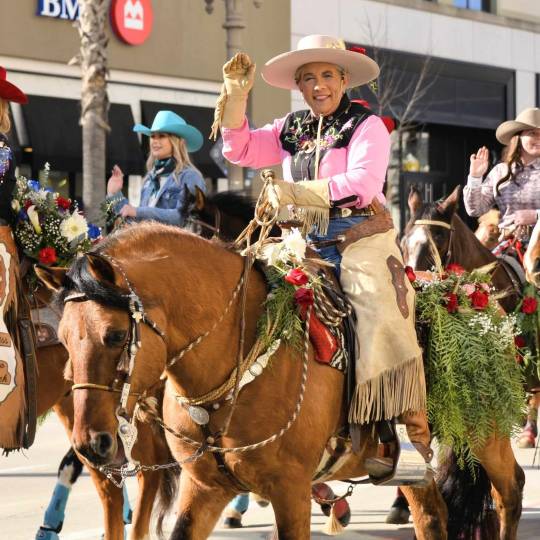

"Look who was in the Rose Parade! This pair is BLM volunteer, Sue Watkins of Riverside, CA, and her mustang, Dime, who comes from BLM Oregon & Washington's Kiger herd. This year was Sue’s first time in the Rose Parade, and they rode as part of the Cowboy Channel’s Cowgirls Rule float entry.
Riding in the Rose Parade requires lots of preparation-think applications, veterinary health certifications, shoeing requirements—that take months to complete, as well as lining up for the parade starting the night before. When some of the original riders were unable to make the parade, Sue and several new riders were added three days before the parade to the Cowgirls Rule equestrians. They managed to get everything lined up, literally, in time for the parade.
Sue is an essential Bureau of Land Management - California wild horse and burro volunteer who helps with everything from adoption compliance to serving as an ambassador for the program. In addition to volunteering, Sue is also a competitor and carded judge for the Gypsy Vanner Horse Society, Equine Trail Sports, and Working Equitation. She and Dime compete in Equine Trail Sports and Working Equitation. Dime is a national champion Working Equitation horse!
Sue and Dime, congratulations on a great first Rose Parade and thank you for showing the world the value of the trained mustang!"
21 notes
·
View notes
Text
Excerpt from this press release from the Center for Biological Diversity:
More than 16 members of the House of Representatives introduced legislation today that would prohibit organizing, sponsoring, conducting or participating in wildlife killing contests on more than 500 million acres of U.S. public lands.
Wildlife killing contests are organized events during which participants compete for cash or prizes by killing the most, the largest or the smallest animals over a certain period of time. Each year thousands of native carnivores and other wildlife — including coyotes, foxes, bobcats, raccoons, rabbits, prairie dogs, mountain lions and wolves — are killed during these cruel, senseless competitions.
The Prohibit Wildlife Killing Contests Act of 2024, introduced by Rep. Steve Cohen (D-Tenn.) and other congressional leaders, would require the Bureau of Land Management, Bureau of Reclamation, National Park Service, U.S. Fish and Wildlife Service and U.S. Forest Service to enact regulations banning wildlife killing contests within one year of enactment of the law.
“It’s shocking that these cruel and reckless contests are still allowed on our public lands,” said Stephanie Kurose, deputy director of government affairs at the Center for Biological Diversity. “America’s wild carnivores are so important to maintaining healthy ecosystems. They deserve better than to be targeted in these thrill-kill slaughter fests.”
Ten states — Arizona, California, Colorado, Maryland, Massachusetts, New Mexico, New York, Oregon, Vermont and Washington — have already outlawed wildlife killing contests within their borders. The Humane Society of the United States conducted undercover investigations into these competitions in more than a dozen states, spurring significant public outrage against the events.
14 notes
·
View notes
Text
Hundreds of US early ballots destroyed after drop boxes targeted by fire
Unknown people have set fire to mailboxes in the US states of Oregon and Washington, causing hundreds of election ballots to burn in Washington.
In the city of Portland on Monday, unknown assailants planted an “incendiary device” in a ballot box meant for voting in the upcoming US presidential election.
Rescuers managed to extinguish the blaze and are now counting how many ballots were lost in the ballot box, located in a car park near the Fishers Landing transit centre in Vancouver, across the Columbia River from Portland, Oregon. Clark County auditor Greg Kimsey told Oregon Live:
“It appears that a device was attached to the outside of the ballot drop box that resulted in the ballots being ignited. We don’t have the exact number [of ballots], but it was hundreds.”
Across the river, the Portland Police Department responded to a fire in a ballot box around 3:30 a.m. Monday. The Portland Police Bureau explained in a statement:
“By the time officers arrived, the fire had already been extinguished by security personnel who work in the area. Officers determined an incendiary device was placed inside the ballot box and used to ignite the fire.”
Investigators attached to the Portland Fire Department, who have specialised skills in investigating fire cases, as well as relevant equipment and even specially trained dogs that can smell traces of incendiary substances, also arrived at the scene.
Shortly before that, US President Joe Biden cast an early vote in the elections of the head of state in the state of Delaware. The Laboratory of Electoral Processes at the University of Florida reported that 43 million Americans had already voted in the election.
A few days ago, 35-year-old Dieter Klofkorn was arrested for setting fire to a mailbox, causing about 20 ballots to be damaged. The perpetrator himself stated that he did not do it out of political motives, but “just to get arrested.”
Read more HERE

#world news#news#world politics#usa#usa news#usa politics#united states#usa election#us elections#us politics#election 2024#presidential election#elections 2024#us election#politics#donald trump#trump 2024#kamala harris#harris walz 2024#harris for president#harris walz rally#harris trump debate#voters#ballout
2 notes
·
View notes
Text
More than 16 members of the House of Representatives introduced legislation today that would prohibit organizing, sponsoring, conducting or participating in wildlife killing contests on more than 500 million acres of U.S. public lands.
Wildlife killing contests are organized events during which participants compete for cash or prizes by killing the most, the largest or the smallest animals over a certain period of time. Each year thousands of native carnivores and other wildlife — including coyotes, foxes, bobcats, raccoons, rabbits, prairie dogs, mountain lions and wolves — are killed during these cruel, senseless competitions.
The Prohibit Wildlife Killing Contests Act of 2024, introduced by Rep. Steve Cohen (D-Tenn.) and other congressional leaders, would require the Bureau of Land Management, Bureau of Reclamation, National Park Service, U.S. Fish and Wildlife Service and U.S. Forest Service to enact regulations banning wildlife killing contests within one year of enactment of the law.
“It’s shocking that these cruel and reckless contests are still allowed on our public lands,” said Stephanie Kurose, deputy director of government affairs at the Center for Biological Diversity. “America’s wild carnivores are so important to maintaining healthy ecosystems. They deserve better than to be targeted in these thrill-kill slaughter fests.”
Ten states — Arizona, California, Colorado, Maryland, Massachusetts, New Mexico, New York, Oregon, Vermont and Washington — have already outlawed wildlife killing contests within their borders. The Humane Society of the United States conducted undercover investigations into these competitions in more than a dozen states, spurring significant public outrage against the events.
“Wildlife killing contests are cruel events that have no place in modern civil society,” said Johanna Hamburger, director and senior attorney for the Animal Welfare Institute’s Terrestrial Wildlife Program. “Participants frequently violate the fundamental hunting principle of fair chase by using bait and electronic calling devices to maximize the likelihood of winning, and animal carcasses are usually dumped once the contest is over.”
“Most people are shocked to learn that wildlife killing contests are even legal on our public lands,” said Camilla Fox, founder and executive director of Project Coyote. “Killing animals for prizes and entertainment is ethically indefensible, ecologically reckless, and anathema to sound wildlife conservation and management.”
“In addition to being unethical and unsportsmanlike, wildlife killing contests run counter to science-based wildlife management policy,” said Jennifer Eskra, director of legislative affairs of the Humane Society Legislative Fund. “This bill would end this execrable practice and protect wildlife at a national level, something that 10 states have already done.”
“Wildlife killing contests have absolutely no place in our country, including on our public lands,” said Katie Stennes, senior program manager for wildlife protection at the Humane Society of the United States. “These ‘cash for wildlife’ competitions, where native species are targeted, killed and then piled up for photos and bragging rights, is unacceptable. These animals should be respected for their intrinsic value and their key role in healthy ecosystems. We urge Congress to end senseless, wasteful wildlife killing competitions once and for all.”
Additional cosponsors of today’s legislation are Reps. Earl Blumenauer (OR-03), Cori Bush (MO-01), Gerald Connolly (VA-11), Diana DeGette (CO-01), Lloyd Dogget (TX-35), Adriano Espaillat (NY-06), Raul Grijalva (AZ-07), Jared Huffman (CA-02), Ted Lieu (CA-36), Betty McCollum (MN-04), Grace Meng (NY-06), Jerrold Nadler (NY-12), Katie Porter (CA-45), Melanie Stansbury (NM-01), Rashida Tlaib (MI-13) and Dina Titus (NV-01).
#ecology#enviromentalism#public lands#wildlife#wildlife conservation#coyote#foxes#bobcat#raccoon#rabbit#mountain lion#wolves#let wolves live#bureau of land management#national park service#us forest service#us fish and wildlife service#wildlife services
3 notes
·
View notes
Text
youtube
VINTERSEA - Crack of Light (Official Music Video) VINTERSEA - Crack of Light (Official Music Video). Taken from the album 'Illuminated', available now via M-Theory Audio. Order 'Illuminated' and VINTERSEA merch today, including the brand new "Crack of Light" shirt designed by Xenoyr (Ne Obliviscaris, Antiqva) from https://ift.tt/CVxMX6d and https://ift.tt/REAp13O Facebook: https://ift.tt/CgTuFKI Bandcamp: https://ift.tt/XOf312k Instagram: https://ift.tt/MSulJgP Spotify: https://ift.tt/l6U7oVj Video produced, directed, and edited by Karl Whinnery of Hotkarlproductions. https://ift.tt/13DmVjL VINTERSEA proudly endorses Balaguer Guitars. www.balaguerguitars.com https://ift.tt/YUhETHy VINTERSEA proudly endorses Galaxy Audio in-ear monitoring products. https://ift.tt/eovd5cp ---- All music and lyrics by VINTERSEA. VINTERSEA is Avienne, Riley Nix, Jorma Spaziano, Jeremy Spencer, and Karl Whinnery. Featuring David Albert Floratos on saxophone. Engineered and mixed by Gabe Johnston at Falcon Recording Studio. Mastered by Troy Glessner at SPECTRE Mastering. Cast: The Queen: Avienne The Oracle: Pixie LePêche The Handmaiden: Candice Louise Nix The Omega: Karl Whinnery The Betrayer: Jorma Spaziano The Seeker: Jeremy Spencer The Goliath: Riley Nix The Flag Bearer: Kirby Nix The Fallen: Freddy Heath The Siren: David Albert Floratos Special Thanks: Freddy Heath, Josh Whinnery, Paula Lawrence, Phyllis Barton, Stephanie Stach, Sherrie Jones Spaziano, Rylan Woodrow, Kirby Nix, Candice Louise Nix, Jordan and Kimberly Hockensmith, Sarah Jane, James Sweet. Filmed at the Alvord Desert in Oregon on public lands managed by the Bureau of Land Managements, Burns District Office. Filmed at Polar Berry Farms in Washington County, Oregon. Additional Location Scouting Courtesy of HiOregon. -- LYRICS: Waiting for the Sun Rising Reaching for the One Life Searching for the Secret Antidote Fell into your Deepest Lies Step on the bridge of the dawn End of the secret Igniting the sky with the one Hope that has failed to die The rumbling earth shakes our thoughts Casting dark shadows The peril that we live lives on Unleashing the wicked Lies! Deceit! The end of retreat! Waves upon us collide Is this our fate? A world without light? Can we carry on? Roaring crack of light Is raging in our souls Fading of father’s might Suffer in demise Carry me From this dream Watch it all Crumble and fall Roaring crack of light Is raging in our souls Failing of father’s light Suffer in demise Carry me From this dream Watch it all Crumble and fall via YouTube https://www.youtube.com/watch?v=1qWrrvPtZ4g
1 note
·
View note
Video
Steens Mountain Wilderness by Bureau of Land Management Oregon and Washington Via Flickr: The United States Congress designated the Steens Mountain Wilderness in 2000 and it now has over 170,200 acres. All of this wilderness is located in Oregon and is managed by the Bureau of Land Management. Steens Mountain is located in Oregon's high desert is one of the crown jewels of the state's wildlands. It is some of the wildest and most remote land left in Oregon. Opportunities for recreation on Steens Mountain are as plentiful as they are widespread. Popular activities include camping, picnicking, sightseeing, and exploring the open country on foot and horseback. Hiking is available in all areas and trailheads exist near Page Springs and South Steens Campgrounds, as well as Wildhorse Overlook and Pike Creek. Visitors photograph landscapes, wildlife and wildflowers, and catch redband trout in the Donner und Blitzen River. Others enjoy hunting for wild game and visiting special places, cross-country skiing, and snowshoeing. For more information contact: 28910 Hwy 20 West Hines, OR 97738 541-573-4400 [email protected]
Wish I could make a trip there this year, but that is not on the agenda. It is a haunting place
#basin and range#Recreation#outdoor recreation#Oregon#Washington#hiking#sightseeing#outdoors#Pacific Northwest#America’s Great Outdoors#BLM#Explore#Bureau of Land Management#Department of the Interior#Burns#Steens Mountain#Wilderness#Camping#Wildlife#Fishing#Hunting#Auto Tour#Wild Horses#Rock Collecting#Overlook#Historical Site#Trailhead#Alvord Peak#Red Mountain#Frog Spring
8 notes
·
View notes
Photo





BLM employees stretch their wings as UAS/drone operators
Throughout the cloudy June afternoon, BLM radios crackled to life with Oregon voices in Montana’s Bozeman Valley, just as they do on incidents such as wildland fires, where air resources play a critical role and their safe management is one of the BLM’s highest priorities.
There was no actual Harper Fire, though. It was just one part of a series of elaborate hands-on exercises for a national team of advanced BLM remote pilots flying Unmanned Aircraft Systems—known colloquially as drones.
During the first two weeks of June, five BLM Oregon/Washington employees participated alongside employees from other federal bureaus and states in two Department of the Interior/Bureau of Land Management UAS drone training courses in Bozeman, Montana, put on by the National UAS Program.
Tavis Fenske (an engine captain from Prineville District), Matthew Noss (a supervisory range technician from Prineville District), Jesse Morris (a supervisory range technician [fire] from Lakeview District), and Greg Shine (a public affairs specialist from the State Office) all completed the Unmanned Aircraft Systems Basic Remote Pilot Training (A-450) course and the Advanced UAS Workshop over the two-week period. Jason Horstman from Vale District also served as one of the instructors and cadre members for the A-450 course.
“I was really excited at the opportunity to learn more about UAS operations and how it may make the job that we do every day safer and more efficient,” said Morris. “This class and workshop have really been an eye opener for me regarding all the uses for UAS within natural resource work. I look forward to bringing these tools and knowledge back to my district and putting it to work in a variety of areas this season.”
In the basic A-450 course, students learned about UAS policy and how to file a Notice to Airmen (NOTAM), how to safely fly the 3DR Solo aircraft, and how to capture images and videos with the GoPro payload. After successfully passing a written final exam and an individual evaluation flight administered by an authorized DOI Office of Aircraft Services inspector, Fenske, Noss, Morris and Shine moved on to the advanced workshop the following week.
Through the advanced workshop—with its focus on UAS for fire operations and complex photography, videography, mapping, and resource projects—the students developed the skills required to capture and pre-process (geotag) data and coordinate with incident personnel and aircraft.
Workshop highlights included resource mapping projects integrating gathered data into PhotoScan software and Gaia and Avenza maps—plus the fire incident scenario, complete with real-time radio traffic and its inherent communications complexities.
“In fire, I think the UAS program will become a new tool that will allow us to gain situational awareness quickly and efficiently, said Noss. “The biggest takeaway I have from the class is that the program is in its infancy and as technology advances, who knows what can become of it.”
Noss's observation seems prescient, as the BLM is poised to continue its leading role in the vanguard of federal UAS programs. This is an additional appeal to the and the newly-minted remote pilots who join the growing ranks of certified staff in Oregon/Washington and nationwide.
"I think it is pretty cool that the BLM is the nation's leading agency in the use of drone technology, " said Fenske, "and I'm excited to be a part of such a forward-thinking program. I'm really looking forward to applying—and developing—my new skills in the field."
38 notes
·
View notes
Link
The Bureau of Land Management’s latest assault on the West’s biodiverse pinyon-juniper forests and sagebrush communities dwarfs its many predecessors. The Trump regime is finalizing a “Restoration” EIS targeting 38.5 million acres of public land across 6 states – Nevada, Oregon, Idaho, Washington, Utah and California. The 60,156 square mile land area is larger than Pennsylvania, New Jersey and Delaware combined. This wrecking balls’ official title is “Programmatic EIS for Fuels Reduction and Rangeland Restoration”.
BLM’s falsely named “restoration” focuses on woody plant destruction projects that turn beautiful wild places into dirt, grass and often flammable weeds. The beneficiaries of this mammoth taxpayer-funded wildlife habitat destruction scheme will be the 18,000 public lands Welfare Ranchers who have the revocable privilege of holding federal grazing permits. The EIS is a surefire way for cattlemen to maneuver for increased grazing, especially if the “restored” sites become infested with flammable cheatgrass or other weeds. After BLM smashes sagebrush or grinds pine nut forests into wood chips under its new EIS, the agency can turn right around and intensify livestock use in a “targeted grazing treatment” by claiming cows will reduce flammable weeds generated by the project....
The EIS proclaims: The purpose of the project is to enhance the long-term function, viability, resistance and resilience of sagebrush communities through vegetation treatments to protect, conserve, and restore sagebrush communities and to provide for multiple use opportunities. “Multiple use opportunities” = more cows. BLM also states its actions support the goals of the Sage-grouse plans. Regrettably, that’s true. Those plans weren’t based on effectively controlling livestock impacts. Instead, they scapegoated native forests, “unhealthy” sagebrush and wild horses as demons that must be slain or vanquished for the bird to endure, and they gave a big boost to these radical deforestation and sage killing projects.
A BLM modeling scheme (FIAT, Fire and Invasives Assessment Tool) tied to the Grouse plans zeroed in on 5.6 million acres (outside Wilderness, WSAs and ACECs) for various forms of mutilation. Riffing off the FIAT scheme, Trump’s Restoration EIS ballooned the project acreage over six-fold, to 38.5 million acres described as “current and historical extent of sagebrush on BLM-administered land within the project area with wilderness areas, WSAs, ACECs removed”. After BLM tears up the country, it doesn’t even have to seed native plants. Non-native crested wheatgrass and forage kochia can be planted at BLM’s whim if the agency finds “resource management objectives cannot be met with native species”.
Besides bullhogs, bulldozers, chaining, mastication, rollerbeaters, mega-mowers and clearcutting, the EIS’s “prescribed fire” includes broadcast, jackpot, and pile burning and bulldozing fire lines. Doses of chemical cocktails of one or more of the following: 2,4-D, bromacil, chlorsulfuron, clopyralid, dicamba, diuron, glyphosate, hexazinone, imazapyr, metsulfuron methyl, picloram, sulfometuron methyl, tebuthiuron, triclopyr, imazapic, diquat, diflufenzopyr (in formulation with dicamba), fluridone, aminopyralid, fluroxypyr, and rimsulfuron can be applied in both an air and ground campaign – and not just to kill non-native plants. Toxics like Tebuthiuron are used to kill trees and shrubs as a “treatment”. The EIS’s major sleeper element is the transformation of the cows that have caused land degradation and weed proliferation into saviors of the range.
In the Owyhee Canyonlands jackpot burning of ancient Western Junipers, contractors cut down tens of thousands of trees so they fell into ancient trees or covered the ground surface. They were left to dry out for a year. Then napalm ping pong balls lobbed from contractor helicopters rained down on the forest, generating an inferno.

36 notes
·
View notes
Photo

TASK 036 : GOVERNORS OF THE UNITED STATES
in the united states, a governor serves as the chief executive officer and commander-in-chief in each of the fifty states, functioning as both head of state and head of government therein. as such, governors are responsible for implementing state laws and overseeing the operation of the state executive branch. as state leaders, governors advance and pursue new and revised policies and programs using a variety of tools, among them executive orders, executive budgets, and legislative proposals and vetoes. governors carry out their management and leadership responsibilities and objectives with the support and assistance of department and agency heads, many of whom they are empowered to appoint. a majority of governors have the authority to appoint state court judges as well, in most cases from a list of names submitted by a nominations committee.




the NORTHEASTERN UNITED STATES is a geographical region of the united states. its divisions are new england ( connecticut, maine, massachusetts, new hampshire, rhode island, and vermont ) and the mid-atlantic ( new jersey, new york, and pennsylvania ). although it lacks a unified cultural identity, the northeastern region is the nation's most economically developed, densely populated, and culturally diverse region. of the nation's four census regions, the northeast has the second-largest percentage of residents living in an urban setting ( with 85 percent ) and is home to the nation's largest metropolitan area ( new york city ).
NEW ENGLAND. CONNECTICUT : laura wilmer ( cate blanchett ), republican, since 2011 MAINE : caitlin westcott ( ellen pompeo ), republican, since 2019 MASSACHUSETTS : felicity benson ( rashida jones ), democrat, since 2015 NEW HAMPSHIRE : christi goode ( reese witherspoon ), democrat, since 2017 RHODE ISLAND : adela sebti ( emmanuelle chriqui ), democrat, since 2015 VERMONT : derick han ( john cho ), democrat, since 2017 MID-ATLANTIC STATES. NEW JERSEY : shaun russell ( laurence fishburne ), democrat, since 2018 NEW YORK : isabelle andrews ( zoe saldana ), democrat, since 2021 PENNSYLVANIA : violet beck ( rooney mara ), republican, since 2015




the MIDWESTERN UNITED STATES is one of four census regions of the united states census bureau, occupying the north central part of the united states. its divisions are east north central ( illinois, indiana, michigan, ohio, and wisconsin ) and west north central ( iowa, kansas, minnesota, missouri, nebraska, north dakota, and south dakota) ). chicago is the most populous city in the american midwest and the third most populous in the entire country. chicago and its suburbs, called chicagoland, form the region’s largest metropolitan area with 10 million people.
EAST NORTH CENTRAL STATES. ILLINOIS : tracey marsh ( sally hawkins ), republican, since 2019 INDIANA : garth butler ( justin chambers ), republican, since 2017 MICHIGAN : donna randall ( viola davis ), democrat, since 2019 OHIO : philip tirrell ( donald glover ), democrat, since 2019 WISCONSIN : percy hewitt ( john mulaney ), democrat, since 2019
WEST NORTH CENTRAL STATES. IOWA : kelly grant ( rachel weisz ), democrat, since 2017 KANSAS : dale garner ( clancy brown ), republican, since 2019 MINNESOTA : sadie lawrence ( winona ryder ), democrat, since 2019 MISSOURI : andrea miller ( michele dockery ), republican, since 2018 NEBRASKA : silas nelson ( sam elliott ), republican, since 2015 NORTH DAKOTA : samuel fulton ( daveed diggs ), democrat, since 2016 SOUTH DAKOTA : alicia atkins ( aja naomi king ), democrat, since 2019





the SOUTHERN UNITED STATES is is a geographic and cultural region of the united states. its divisions are the south atlantic ( delaware, florida, georgia, maryland, north carolina, south carolina, virginia, and west virginia ), east south central ( alabama, kentucky, mississippi, and tennessee ), and west south central ( arkansas, louisiana, oklahoma, and texas ). the south does not precisely coincide with the geographic south of the united states but is commonly defined as including the states that fought for the confederate states of america in the american civil war. the deep south lies entirely within the southeastern corner. the region is known for its culture and history, having developed its own customs, musical styles, and cuisines, which have distinguished it in some ways from the rest of the united states. the southern ethnic heritage is diverse and includes strong european ( mostly english, scotch-irish, scottish, irish, and french ), african, and some native american components.
SOUTH ATLANTIC STATES. DELAWARE : cornelius bancroft ( michael shannon ), republican, since 2017 FLORIDA : angela valdes ( gina torres ), democrat, since 2019 GEORGIA : gabrielle shaw ( octavia spencer ), democrat, since 2019 MARYLAND : damien park ( daniel dae kim ), democrat, since 2015 NORTH CAROLINA : artie barnes ( sam richardson ), democrat, since 2017 SOUTH CAROLINA : shannon todd ( leslie mann ), republican, since 2017 VIRGINIA : rebekah milton ( julianne moore ), republican, since 2018 WEST VIRGINIA : lori taylor ( helen mccrory ), republican, since 2017
EAST SOUTH CENTRAL STATES. ALABAMA : maynard gardner ( richard jenkins ), republican, since 2011 KENTUCKY : wilson beaumont ( kevin costner ), republican, since 2019 MISSISSIPPI : julianne hargrave ( amy adams ), republican, since 2012 TENNESSEE : shane montgomery ( andrew lincoln ), republican, since 2019
WEST SOUTH CENTRAL STATES. ARKANSAS : jason wickham ( eddie redmayne ), republican, since 2015 LOUISIANA : christine robson ( antonia thomas ), republican, since 2016 OKLAHOMA : michele abrams ( lea thompson ), republican, since 2019 TEXAS : lorraine crawford ( kelly reilly ), republican, since 2015




the WESTERN UNITED STATES is the region comprising the westernmost states of the united states. its divisions are the mountain states ( arizona, colorado, idaho, montana, nevada, new mexico, utah, and wyoming ) and the pacific states ( alaska, california, hawaii, oregon, and washington ). as american settlement in the united states expanded westward, the meaning of the term “the west” changed. before about 1800, the crest of the appalachian mountains was seen as the western frontier. the frontier moved westward and eventually the lands west of the mississippi river were considered “the west.” the west contains several major biomes, including arid and semi-arid plateaus and plains, particularly in the american southwest; forested mountains, including two major ranges, the american sierra nevada and rocky mountains; the long coastal shoreline of the american pacific coast; and the rainforests of the pacific northwest.
MOUNTAIN STATES. ARIZONA : daniel rivera ( alfonso herrera ), democrat, since 2019 COLORADO : wyatt harvey ( forest whitaker ), democrat, since 2015 IDAHO : malcolm jackson ( michael fassbender ), republican, since 2019 MONTANA : omar faraj ( marwan kenzari ), democrat, since 2021 NEVADA : noelle bloomfield ( maya rudolph ), democrat, since 2019 NEW MEXICO : oscar méndez ( diego luna ), democrat, since 2019 UTAH : william daniels ( seth meyers ), republican, since 2021 WYOMING : colleen leighton ( felicity jones ), republican, since 2019
PACIFIC STATES. ALASKA : veronica filippova ( mila kunis ), republican, since 2018 CALIFORNIA : maria reyes ( salma hayek ), democrat, since 2019 HAWAII : makaio kekoa ( keanu reeves ), democrat, since 2014 OREGON : isadora tyler ( susan sarandon ), democrat, since 2015 WASHINGTON : felix kessler ( jeff goldblum ), democrat, since 2013
8 notes
·
View notes
Text
Things Biden and the Democrats did, this week #21
May 31-June 7 2024
As part of President Biden's goal to bring the number of traffic deaths to zero, the Department of Transportation has sent $480 million in safety grants to all 50 states, DC, and all the US territories. The grants will focus on trucks, buses and other large vehicles. Thanks to DoT safety actions deaths involving heavy vehicles dropped by 8% from 2022 to 2023 and the department wants to keep pushing till the number is 0.
The Departments of Interior and Agriculture announced $2.8 billion plan to protect public land and support local government Conservation Efforts. $1.9 billion will be used to repair and restore national parks and public land, restoring historic sites, as well as Bureau of Indian Education-funded schools. $900 million will go to conservation funding, allowing the government to buy land to protect it. Half the funds will go to the federal government half to state and local governments and for the first time ever a tribal Conservation Land Acquisition program has been set up to allow tribal governments to buy land to protect nature.
The Department of Transportation announced that it had managed to get customers nearly $1 Billion dollars worth of flight reimbursements. The DoT reached an agreement with 3 airlines, Lufthansa, KLM, and South African Airways to pay between them $900 million to passengers effected by Covid related cancellations and delays. This adds to the $4 billion dollars of refunds and reimbursements to airline passengers under the Biden Administration.
The Department of Interior announced $725 million to clean up legacy coal pollution. This is the 3rd pay out from the $11.3 billion dollars President Biden signed into law in the Bipartisan Infrastructure Law to clean up coal pollution and invest in communities that used to rely on the coal industry. The money will be spent across 22 states and the Navajo Nation. Closing dangerous mine shafts, reclaim unstable slopes, improve water quality by treating acid mine drainage, and restore water supplies damaged by mining.
HUD launches the first of its kind investment program in manufactured homes. Manufactured homes represent a major market for affordable housing and the Biden Administration is the first to offer support to people trying to buy. HUD hopes the program will help 5,000 families and individuals buy their own home over the next 5 years.
The Department of the Interior announced $700 million for long-term water conservation projects across the Lower Colorado River Basin. The Colorado River Basin provides water for more than 40 million people, electric power to 7 US States and is a critical crucial resource for 30 Tribal nations and two Mexican states. The project hopes to save more than 700,000 acre-feet of water in Lake Mead. In the face of climate change causing a historic 23-year drought, there is record low water levels at Lake Powell and Lake Mead. The Biden Administration has moved aggressively to try to protect the Colorado River and make sure there's enough water in the West.
HUD makes $123 million for fighting Youth Homelessness available. This represents the 8th round of investment in Youth Homelessness since 2021 for a total of $440 million so far. The Biden Administration is focusing on innovative answers, like host homes, and kinship care models, with emphasis on creating equitable strategies to assist youth who are most vulnerable, including BIPOC, LGBTQIA+, and youth with disabilities. This is part of the Biden Administration goal of cutting homelessness by 25% by the end of 2025
The Department of Agriculture announced a series of actions to strength Tribal food sovereignty. The USDA will grant tribes in Maine, Alaska, Montana, Nebraska, North Carolina, Oregon and Washington $42 million through the Indigenous Animals Harvesting and Meat Processing Grants to support native animal harvesting. $18 million for projects under the Tribal Forest Protection Act. As well as $2.3 million to support the service of Indigenous foods in school meal programs. The USDA also plans its first ever class of interns specifically focused on Tribal agriculture and food sovereignty. The USDA also plans to host a first ever international trade mission focused on Tribal Nation and Native Hawaiian Community businesses.
Bonus: President Biden, First Lady Jill Biden, and Secretaries of Defense Lloyd Austin and State Antony Blinken traveled to Normandy France to mark the 80th Anniversary of D-Day. They were joined by a handful of surviving veterans of the landings many over 100 years old.
youtube
#Thanks Biden#Joe Biden#us politics#american politics#D-Day#housing#air lines#climate change#conservation#water#colorado river
412 notes
·
View notes
Text
Excerpt from this press release from the Bureau of Land Management:
The Bureau of Land Management (BLM) today announced its proposed roadmap for solar energy development on public lands, designed to expand efficient and environmentally responsible solar project permitting on public lands across the West. Today’s release of the Final Utility-Scale Solar Energy Programmatic Environmental Impact Statement and Proposed Resource Management Plan Amendments (also known as the proposed updated Western Solar Plan), comes as the Biden-Harris administration releases new data to demonstrate how it has improved federal permitting processes to help deliver more projects, more efficiently, across the United States.
The proposed Western Solar Plan builds on President Biden’s Investing in America agenda, which is working to transition the nation to clean energy, lower energy costs for consumers, create good-paying union jobs, tackle the climate crisis, and advance clean air and environmental justice priorities, with the goal of achieving a 100-percent clean electricity grid by 2035. Earlier this year, BLM surpassed the goal of permitting more than 25 gigawatts of clean energy projects on public lands, and the updated Western Solar Plan will support continued progress on responsible permitting.
Developed with substantial public input, the proposed updated Western Solar Plan will guide BLM’s management of solar energy proposals and projects on public lands. It would make over 31 million acres of public lands across 11 western states available for potential solar development, driving development closer to transmission lines or on previously disturbed lands and avoiding protected lands, sensitive cultural resources and important wildlife habitat.
Steering project proposals away from areas where they may conflict with other resources or uses will help ensure responsible development, speed the permitting process, and provide greater predictability to the solar energy industry. The plan updates and expands the original 2012 Western Solar Plan in order to reflect changes in technology and meet the higher demand for solar energy development. This plan analyzes five additional western states (Idaho, Montana, Oregon, Washington, and Wyoming), in addition to the six states analyzed in the original plan. [The original states include California, New Mexico, Arizona, Colorado and Utah.]
No solar developments are authorized through this planning effort; proposed projects will still undergo site-specific environmental review and public comment. This Final Utility-Scale Solar Energy Programmatic Environmental Impact Statement follows a draft published in January 2024 for public comment, with input from a wide range of stakeholders helping BLM to make additional updates that will help protect wildlife habitats and migration corridors and other key resources, while providing clarity to industry about low-conflict areas and project design approaches to guide responsible development.
To date, the Biden-Harris administration has approved 40 renewable energy projects on public lands (9 solar, 13 geothermal, and 18 gen-ties) allowing for early achievement of the goal to permit 25 gigawatts by 2025. In total, BLM has now permitted clean energy projects on public lands with a total capacity of approximately 29 gigawatts of power – enough to power over 12 million homes. This year BLM also issued a final Renewable Energy Rule that will lower consumer energy costs and the cost of developing solar and wind projects, improve project application processes, and incentivize developers to continue responsibly developing solar and wind projects on public lands.
1 note
·
View note
Video
Bureau of Land Management Oregon and Washington || CC BY 2.0
7 notes
·
View notes
Text
Forgotten Portland History: Guild's Lake and the Murder of Ervin Jones
On the night of August 20th, 1945, three plainclothes Portland police officers shot and killed Ervin Jones, a Black man, in his own home.
----------
Jones lived in a home at Guild’s Lake Courts, a wartime housing development in Northwest Portland. Jones’ family was one of many Black southern families that moved to the Pacific Northwest to find work in the shipyards. During the war, the Housing Authority of Portland (HAP) constructed and operated the largest public housing portfolio in the country, with 18,504 units. Across the Columbia river in Vancouver, Washington, the Housing Authority operated 12,389 units, for a combined total of 30,000 units in the metro area. For comparison, New York City’s housing authority operated 13,173 units at that same point in time [1].
The Housing Authority of Portland achieved these numbers through two large development projects: Vanport (see here) and Guild’s Lake Courts. The developers wanted to attract agricultural workers from Northern states (read as: rural Whites), so they built electrified units featuring refrigerators, heaters, and lights. At this time, only 33% of American farms were on the electric grid, and the promise of good paying jobs and modern living brought many new workers to Portland.
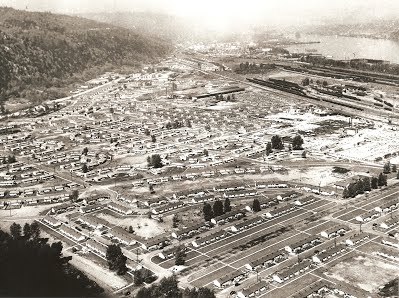
This aerial photo from 1945 shows the Guild Lake housing project at its peak. Forest Park is off to the north of this image, and Downtown is to the south. For more like this photo, the best collection I've seen has been preserved on this website here.
Construction began on the electrified units at Guild’s Lake Courts sometime in 1942. Oregon Congressman Clark Foreman had passed a state housing policy which mandated that local architects be hired to work on any federally-mandated housing projects in the state. The local architects hired for the project included Pietro Belluschi, designer of the Commonwealth Building (the first aluminum-clad office building in the US), and Morris E. Whitehouse, a Portland architecture all-star who designed Temple Beth Israel, the Gus J. Solomon United States Courthouse, both Jefferson and Lincoln High Schools, the Keller Auditorium, and more.
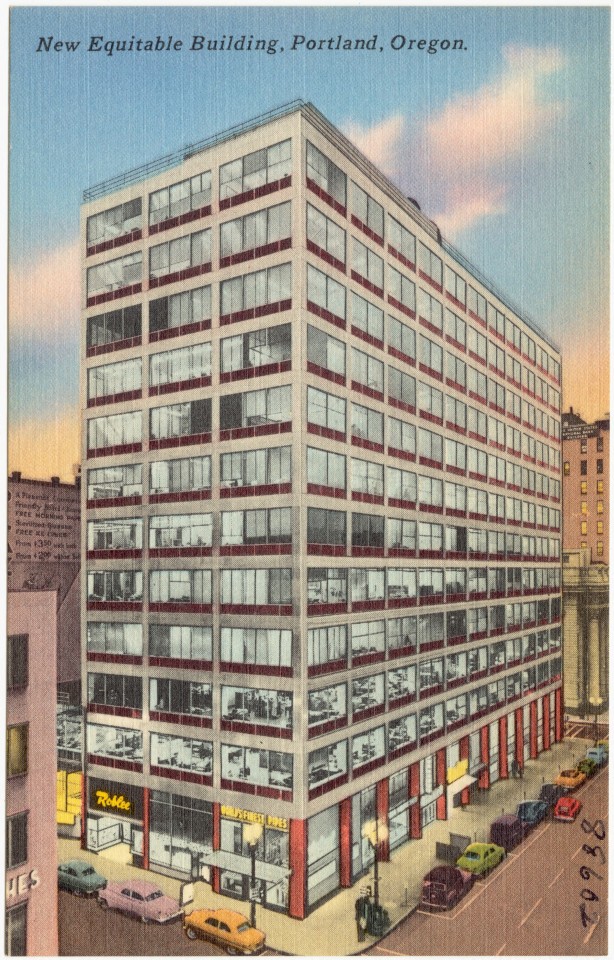
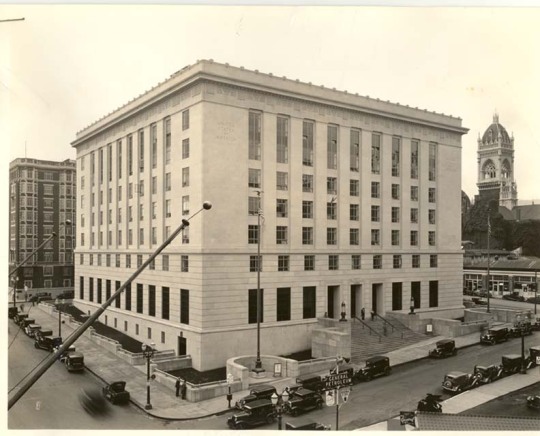
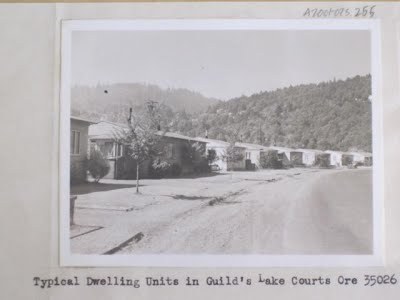
Top: The Commonwealth Building, 1944, designed by Pietro Belluschi, photo wikipedia. Middle: The Gus J. Solomon Courthouse, designed by Morris E. Whitehouse, 1933, photo wikipedia.
Bottom: The Morris E. Whitehouse-designed units at Guild's Lake. As far as I know, there are no photos of the Pietro Belluschi-designed units.
In a country still 10 years from Brown v. Board, and 23 years from the desegregation of Federal housing in 1968, remember that the Guild’s Lake development would have been strictly segregated. “By the time construction started on the units dedicated to African American residents,” writes Dr. Tanya Lynn March, “it was clear that all the electricity that could be spared to operate mechanical refrigerators, hot plates, and electric heaters was going to be absorbed by the round-the-clock operations of the war industries, so homes offered in the black section of Guild's Lake Courts lacked these amenities and were rudimentary in contrast to Portland's existing housing stock” [1]. All of the best land had been used for the construction of the White-designated homes, and the Black-designated homes were built on the marshy land that was left over.

This photo from Dr. March's website shows children playing in sand, but this is not a playground! Since the housing development was built on a marsh and the budget was low, they just filled the area in with sand. This was actually someone's front yard.
On the one hand, it makes sense that as the war continued, supplies grew scarce and the quality of housing suffered. However it’s not a mere coincidence that the same enthusiasm that went into attracting white residents to Guilds Lake did not extend to the Black residents. Without exaggeration and quoting verbatim, Portland Mayor Earl Riley said: “Portland can absorb only a minimum of Negroes without upsetting the city’s regular life” [2]. By 1944, no longer were famous Portland architects involved in Guild’s Lake. The housing was clad in tar paper for weatherproofing. No longer were the homes single-family, detached units. Now, there were 4-plexes and 6-plexes.
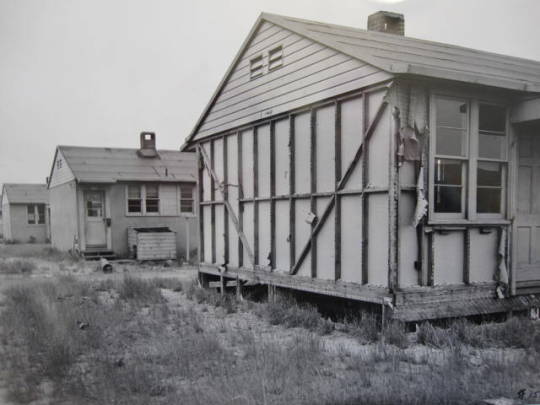
This photo shows the condition of the houses in 1946, when HAP began dismantling units. Photo from Dr. March.
--------- In 1945 the Jones family home would have been full to the brim. Ervin Jones lived there with his wife Elva and their two children. Two of Elva’s sisters and both of their husbands lived in the home, making seven people in all. On the night of the shooting, the other men were working the night shift at the Kaiser shipyards, so Ervin was home with his wife, children, and sisters in law. [3]
Earlier in the night, there had been a domestic disturbance at a house down the street. A man, Scott E. Thomas, shot and killed his girlfriend, Beatrice Terry, in an argument. Police found out about the shooting and received a tip that Thomas was hiding out in the home of Ervin Jones. At 2 AM on the night of August 20th, three plainclothes officers of the Portland Police Bureau made a plan to take Thomas into custody.
Two officers moved into position at the front of the Jones house, and one went to the backdoor. Ervin Jones heard the rustling of the officers and their muffled voices and assumed he was being robbed. He woke up his sister-in-law and his wife to warn them, and then grabbed his gun to protect his family.
The police were looking for Scott E. Thomas, a white man. Instead, they looked inside and saw Ervin Jones, a Black man, with a gun. Detective Purcell, the one at the back of the house, shot him.
Nevermind that Detective Purcell didn’t have a warrant to enter Jones’ home. Nevermind that he didn’t even have a warrant to enter Scott E. Thomas’ home, down the block. Nevermind that Ervin Jones, a black man, did not at all match the description of the suspect, a white man. Nevermind that the actual suspect, Scott E. Thomas, was found later in the night, readily admitted to the crime, and turned himself over to the police without incident. Nevermind all this because it was too late for Ervin Jones, killed in front of his family.
--------- Historian Rudy Pearson writes, “The prejudice [Black families] encountered in Portland surprised many of the newcomers, who could not hide their astonishment at Portland's segregated facilities and the hostile attitudes of many Whites. Before coming to Portland, for example, Bobbie Nunn and her husband had been stationed in army camps in Alabama, Georgia, and Texas. As they moved north, they expected to encounter more liberal attitudes than they had experienced in the South, but they quickly learned that prejudice had no regional boundaries, and Portland seemed like the southern cities they left behind.” [2]
White Portlanders begrudgingly accepted the influx of Black workers for the war effort, no doubt thanks to wheels greased by patriotism and nationalism, but also operated under the assumption that the Black workers would leave once their labor was no longer needed in the shipyards.

Kaiser Shipyards. Henry J. Kaiser is also the founder of Kaiser Permanente hospitals, along with many other ventures. Consider the following link propaganda but read more about Kaiser's choice to circumvent organized labor in order to hire non-white workers, here. Photo wikipedia.
“The Portland area grew from 501,000 to 661,000 in between 1940 and 1944. One could safely assume, in the war years, that every third person standing in line for the bus or a double feature was new to town.” [4]
“From the beginning, HAP officials made it clear that the agency had no obligation to respond to racial discrimination,” continues Pearson. “HAP was simply an ‘agent of private enterprise whose sole function was to manage wartime housing projects and dispose of them as soon as practicable.'" To that end, HAP began dismantling units in 1946. HAP was even offered money to purchase the land required to save some of the units as permanent affordable housing, but declined to do so; hoping that the poor and Black residents would leave and they could sell the land to other landowners in the future. “In some cities, privatization of Defense-era public housing enabled Blacks homeownership opportunities, as in Bayview-Hunters Point, in San Francisco. However, any chance to remain in the Guild’s Lake District and create a coalescent community was unimaginable in Portland, the Jim Crow city of the west,” writes Dr. March [1].
HAP made their priorities clear: their racist calculus led them to conclude that it was better to turn away free money than it was to provide homeownership opportunities to Black residents. And since HAP made the rules, they got their way. The last residents of Guild’s Lake left in 1952, and industrial uses quickly took over the site.
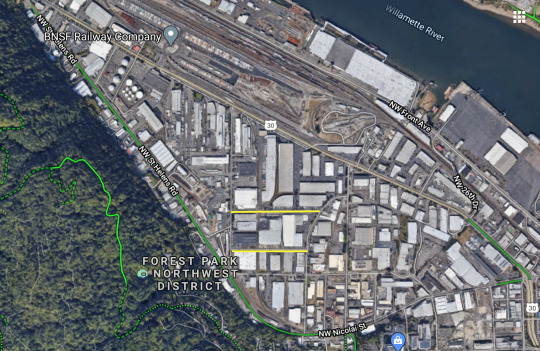
The only urban remnants of Guild’s Lake are two streets: NW Luzon Street and NW Guam Streets (shown above on the map in yellow), which were given Pacific Theater names as a wartime nod. I have heard that both these streets were part of the Black section of housing. As you can see, the area was an advantageous site for industry, but it's depressing to think about what could have been if the housing had been saved.
----------
After her husband was shot and killed by Portland Police, Elva Jones moved back to Louisiana. The Portland Chief of Police launched an investigation into the three officers involved in the shooting and quickly exonerated them of any wrongdoing. Attorney Irvin Goodman and the NAACP worked hard to bring the case to trial, requesting an official coroner’s inquest. In a moment of inter-racial solidarity, the majority-white Portland Council of Churches raised the money to pay for Elva’s travel expenses to Portland for the trial [3].
The six-person jury was all-white. Goodman requested that he be allowed to question the jurors before the trial in order to determine any racial biases, but the judge denied the motion. Next, Goodman argued that because Jones lived in a Black neighborhood, a “jury of his peers” should include at least some Black jurors. Again, the judge denied the motion, and the trial continued.
Elva Jones, her sister Susi, and the next door neighbor testified that the plainclothes police officers never identified themselves as such: confirming that Jones had no way of knowing whether the intruders were police or robbers.
Officer Purcell’s own testimony in the courtroom did not match the testimony he gave on the night of the shooting only two months prior. Purcell framed Jones as an aggressor, saying he was loading a gun and holding the door closed so that the officers could not get in. Police Chief Fleming testified that Scott E. Thomas had in fact been hiding in the Jones’ home, even though he was directly contradicted by Scott E. Thomas himself who testified that he had never been in the Jones’ home, and in fact did not even know of Ervin Jones until after the shooting.
Despite these inconsistencies, the jury exonerated all three officers. The Oregonian reported that the jury found Purcell justified “in performance of duties and in protection of himself and fellow officers. Adding insult to injury, the Portland City Council used taxpayer money to pay the legal expenses for Officer Purcell and the other officers involved in the shooting.
----------
After the Ervin Jones coroner’s inquest, “The NAACP and Urban League suggested city officials adhere to police training recommendations set forth by the City Club detailed in their recently published ‘Negro in Portland’ report (published 1945). Maude B. Leas, secretary of the YWCA, believed law enforcement could eliminate tensions if the police were trained in racial tolerance. However, they continued without that training.” [2]
Last June, I attended a public zoom forum with Portland Mayor Ted Wheeler, Portland Commissioner Jo Anne Hardesty, Urban League of Portland Director Nkenge Harmon-Johnson, and representatives from the Portland NAACP. Discussion topics included racial bias training and other attempts at police reform. Harmon-Johnson was exasperated that the elected leaders in the room continued not to acknowledge the policy reform proposals set forth by the Urban League. It had been 75 years since the 1945 policy recommendations were furnished to police in the wake of Ervin Jones’ murder, and yet conversations in 2020 revolved around the same topics.
I began writing and researching this article back in September of 2020. At the time, I was thinking about the similarities between the story of Ervin Jones in 1945 and Breonna Taylor in 2020. In both cases, the police failed to announce themselves as police, so the residents believed that the intruders were robbers. Both cases resulted in the shooting deaths of innocent Black people.
Tonight, after the murder of Daunte Wright in Minneapolis, 2021, I was reminded of the murder of Oscar Grant in Oakland, 2009. In both cases, Black men were killed when they were shot by police who "accidentally" reached for their handguns instead of their tasers. This isn’t something that should have happened once; and now, 11 years later, it’s happened again.
History is a wheel, and we continue to watch as the lives of innocent Black people are lost, while the gears of our policing and housing machines continue to churn: machines that those with their hands closest to the levers claim they are powerless to stop.
Sources:
[1] Google Site: Guild’s Lake Courts https://sites.google.com/site/guildslakecourts/
[2] "A Menace to the Neighborhood": Housing and African Americans in Portland, 1941-1945, by Rudy Pearson, published in the Oregon Historical Quarterly https://www.jstor.org/stable/20615135
[3] On this we build
[4] Carl Abbott, Portland in three Centuries, p119
Click "keep reading" for the liner notes.
Liner Notes
This article would not be possible without the work so so many people have done, and all of whom seem to be connected to Portland State University. Particularly I’d like to thank Dr. Tanya Lyn March for the incredible resource that is this google site about Guild’s Lake. There is so little information about Guild’s Lake and Dr. March has done incredible work compiling it. If you’re at all interested in primary sources or digging deeper into Guild’s Lake, please please poke around on this website, it’s truly incredible.
I was introduced to the case of Ervin Jones thanks to the book “A Hundred Little Hitlers” by Elinor Langer. This book provides a history of white supremacist groups up and down the west coast and their particular convergence around the murder of Mulugetu Seraw. Her history of the Portland Police Bureau as it appears in this book is part of what got me interested in Ervin Jones’ story.
There have been a number of articles I’ve read that have really given me perspective on the history of civil rights activism in Portland.
I want to call particular attention to "On This, We Shall Build: the Struggle for Civil Rights in Portland, Oregon 1945-1953”, by Justin LeGrand Vipperman. Vipperman’s account of the actual details of the Ervin Jones shooting were incredibly helpful in piecing together a coherent story from a few different sources. Vipperman’s essay is incredibly thought provoking and also a strange reminder of the cyclical nature of history.
More thank you’s and recommended reading: "A Menace to the Neighborhood: Housing and African Americans in Portland, 1941- 1945” by Rudy Pearson.
I cannot recommend enough reading “Portland, Oregon's Long Hot Summers: Racial Unrest and Public Response, 1967-1969” by Joshua Joe Bryan. While this essay did not end up directly relating to what I’ve written here, it has been hugely informative for fleshing out my understanding of the history of racial justice protests in Portland.
There is some really interesting reading to be done in the City Club of Portland’s “The Negro in Portland, 1945” report. This document presents the results of research into available job opportunities across different industries and unions in the city. Results are grim. It’s a document referenced by almost every text dealing with civil rights in the 1940’s in Portland, so if you’re interested in diving into this rabbit hole it’s required reading.
“Vanport Conspiracy Rumors and Social Relations in Portland, 1940-1950” by Stuart McElderry is another great article. You can learn so much about a social climate from the myths and urban legends that circulate within it.
And finally, I’d like to recommend Carl Abott’s book “Portland in Three Centuries.” Over time it’s proved to be an incredible resource, and it’s brimming with crazy and interesting jumping off points for further research.
My deepest thanks to the Multnomah County Library for giving me Jstor access and for loaning me so many books.
1 note
·
View note
Text
youtube
VINTERSEA - Crack of Light (Official Music Video) VINTERSEA - Crack of Light (Official Music Video). Taken from the album 'Illuminated', available now via M-Theory Audio. Order 'Illuminated' and VINTERSEA merch today, including the brand new "Crack of Light" shirt designed by Xenoyr (Ne Obliviscaris, Antiqva) from https://ift.tt/gbtAI6R and https://ift.tt/WpASfrw Facebook: https://ift.tt/UKzMHXL Bandcamp: https://ift.tt/GlHnYR5 Instagram: https://ift.tt/jA96GMw Spotify: https://ift.tt/Qf2szNM Video produced, directed, and edited by Karl Whinnery of Hotkarlproductions. https://ift.tt/1xp8Pz2 VINTERSEA proudly endorses Balaguer Guitars. www.balaguerguitars.com https://ift.tt/PCzxEw2 VINTERSEA proudly endorses Galaxy Audio in-ear monitoring products. https://ift.tt/E4mpXle ---- All music and lyrics by VINTERSEA. VINTERSEA is Avienne, Riley Nix, Jorma Spaziano, Jeremy Spencer, and Karl Whinnery. Featuring David Albert Floratos on saxophone. Engineered and mixed by Gabe Johnston at Falcon Recording Studio. Mastered by Troy Glessner at SPECTRE Mastering. Cast: The Queen: Avienne The Oracle: Pixie LePêche The Handmaiden: Candice Louise Nix The Omega: Karl Whinnery The Betrayer: Jorma Spaziano The Seeker: Jeremy Spencer The Goliath: Riley Nix The Flag Bearer: Kirby Nix The Fallen: Freddy Heath The Siren: David Albert Floratos Special Thanks: Freddy Heath, Josh Whinnery, Paula Lawrence, Phyllis Barton, Stephanie Stach, Sherrie Jones Spaziano, Rylan Woodrow, Kirby Nix, Candice Louise Nix, Jordan and Kimberly Hockensmith, Sarah Jane, James Sweet. Filmed at the Alvord Desert in Oregon on public lands managed by the Bureau of Land Managements, Burns District Office. Filmed at Polar Berry Farms in Washington County, Oregon. Additional Location Scouting Courtesy of HiOregon. -- LYRICS: Waiting for the Sun Rising Reaching for the One Life Searching for the Secret Antidote Fell into your Deepest Lies Step on the bridge of the dawn End of the secret Igniting the sky with the one Hope that has failed to die The rumbling earth shakes our thoughts Casting dark shadows The peril that we live lives on Unleashing the wicked Lies! Deceit! The end of retreat! Waves upon us collide Is this our fate? A world without light? Can we carry on? Roaring crack of light Is raging in our souls Fading of father’s might Suffer in demise Carry me From this dream Watch it all Crumble and fall Roaring crack of light Is raging in our souls Failing of father’s light Suffer in demise Carry me From this dream Watch it all Crumble and fall via YouTube https://www.youtube.com/watch?v=1qWrrvPtZ4g
0 notes